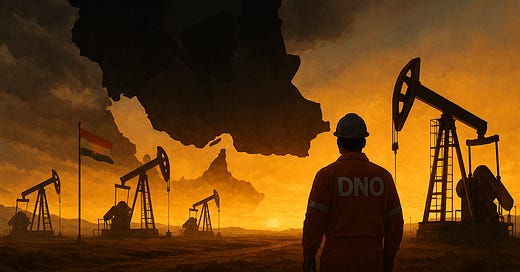After the Ayatollahs: What Iran’s Future Means for Oil Investors in Kurdistan
The real reason DNO’s barrels trade at a deep discount? It’s not Baghdad. It’s Tehran.
Why Kurdistan Oil Investors Should Care Deeply About Iran
Investors in Kurdistan oil plays like DNO ASA (DNO.OL) have become all too familiar with pipeline politics, legal uncertainty, and the deeply discounted barrels being sold into the local market. But many still view these challenges as largely local – an internal Iraqi tug-of-war between Erbil and Baghdad.
That lens is incomplete.
The truth is that Tehran is the most powerful actor shaping the operating environment for International Oil Companies (IOCs) in the Kurdistan Region of Iraq (KRI). From shutting down the Iraq-Turkey Pipeline (ITP) to weaponising the Iraqi judiciary, Iran exerts indirect but decisive control over whether companies like DNO can sell oil at Brent-linked prices or not.
With the ongoing war between Iran and Israel, and renewed speculation about regime change in Tehran, it's time for investors to reassess what lies on the other side of the risk discount. Because a change in Iran could be the single most transformative catalyst for re-rating DNO and its peers.
Iran: The Architect of Instability
Tehran does not simply influence Baghdad from the sidelines. It has built a multi-layered web of power in Iraq – via Shia militias, political proxies, and judiciary manipulation – designed to keep the Kurdistan Region fragmented, underfunded, and geopolitically isolated.
Why? Because a strong, autonomous, pro-Western KRG is viewed by the Iranian regime as a direct security threat.
This explains why:
The ITP remains closed despite technical readiness.
The Federal Supreme Court ruled the KRG's oil law unconstitutional.
Militia strikes and cyberespionage routinely target KRG institutions.
All of these are levers used by Tehran to apply indirect economic pressure on companies like DNO, Gulf Keystone (GKP.L), and Genel Energy (GEN.L).
DNO in the Crossfire
Despite being one of the most operationally resilient producers in the region, DNO is forced to sell its oil at around $35 per barrel into the local market. That’s less than half the Brent benchmark. And yet, even under these conditions, the company is generating positive free cash flow – a testament to its lean operating model.
But let’s be clear: this is a survival mode, not a growth model.
The current valuation of DNO does not reflect the quality of its reserves or its operational excellence. It reflects one thing above all: the geopolitical chokehold Iran maintains over the region.
Three Futures After the Regime
A scenario analysis reveals that the nature of a regime change in Iran matters far more than the fact of regime change itself. Here are three plausible futures – and what each could mean for DNO and other Kurdistan-focused IOCs:
State Collapse ("Syria/Yemen model")
In this scenario, the Islamic Republic disintegrates into civil strife, ethnic fragmentation, and militia-led governance. Iranian state capacity collapses, along with its ability to meddle in Iraq. That likely removes the political roadblocks to reopening the Iraq–Turkey Pipeline. But the vacuum would create a highly unstable security situation along the Iranian–KRI border.For DNO: Reopening of the pipeline would restore Brent-linked pricing, but regional instability and potential disruption to cross-border logistics and export infrastructure could still introduce operational risks.
IRGC-Led Nationalist Regime ("Iran First")
If the IRGC consolidates control post-clerics, Iran transforms into a nationalist military-industrial state. Its foreign policy remains hostile toward Kurdish autonomy, but with more efficiency and discipline. Baghdad continues to be used as a political and legal weapon against Erbil.For DNO: The status quo persists – discounted sales, legal ambiguity, and suppressed valuations. North Sea assets become increasingly important for cash flow stability.
Democratic Transition ("Velvet Revolution")
The most bullish scenario – a secular, reformist government seeks reintegration with the global economy. Regional proxy warfare ends. Iraq's domestic institutions face less external pressure, paving the way for a new federal oil law that could formally recognise Production Sharing Contracts (PSCs).For DNO: A game-changer. Full pricing power returns, legal risks fall, and new capital can be deployed into growth. Shares re-rate materially.
Why This Matters Now
Markets tend to price in what they can see. Right now, they see status quo or Scenario B: continued paralysis, soft conflict, and muted returns.
But geopolitical inflection points rarely come with a warning. If we start to see signs of Scenario C emerging – mass protests, elite defections, or shifts in Iranian rhetoric – investors who moved early could benefit from an asymmetric upside.
For DNO, this could mean a shift from $35 crude back to Brent pricing – with no drilling required. The same reserves, the same wells, just a different border dynamic. And that’s before accounting for the possibility of new investment and a broader institutional shareholder base finally willing to engage.
Conclusion: Iran Is the Catalyst
If you’re invested in Kurdistan IOCs, you're already exposed to Iran – whether you realise it or not.
The shutdown of the ITP, the legal ambiguity of PSCs, and the valuation suppression of names like DNO, GKP, and Genel all flow from Tehran’s strategy.
A regime change in Iran could flip that entire thesis.
Disclaimer: This article is for informational and educational purposes only and does not constitute investment advice. Always conduct your own research or consult a financial advisor before making investment decisions. The author may hold positions in the mentioned securities.




